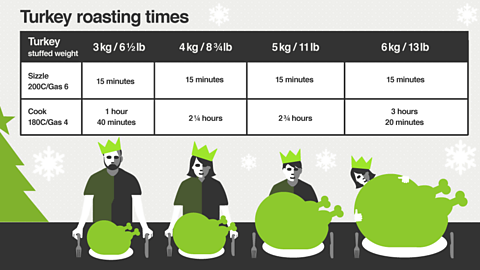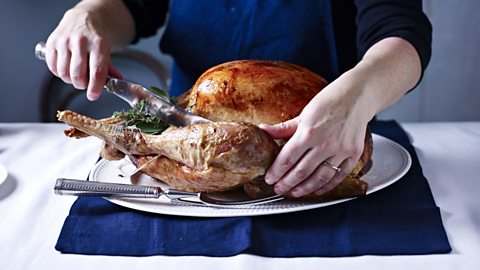How to cook a turkey

Weâve been gobbling up turkeys at Christmas for hundreds of years. Henry VIII is said to have been the first British king to feast on roast turkey, but Edward VII made it a festive fashion, and since the 1950s itâs been at the heart of the traditional family Christmas dinner. Nigel Slater once said, "We eat turkey because it's the biggest thing we can kill. Size matters."
These days, people are more inclined to go with a smaller, neater turkey crown or even boneless turkey breast recipes. Perhaps they don't relish being left wondering what to do with leftover turkey for the next three days. But even so, the lone annual appearance of this bird sends us desperately searching the internet on Christmas Eve for last-minute Christmas turkey recipes, times and temperatures, and increasingly specific questions about quick defrosting and dropping the bird.
How long to defrost a turkey?
A frozen turkey should be defrosted at a cool temperature (no more than 17.5C) and must be thoroughly defrosted before cooking. In a fridge, at 4C, allow at least 4 hours for every 450g. This is the safest way to defrost a turkey. In a cool room allow about 2 hours for every 450g. The same applies to defrosting a turkey crown.

How long to cook a turkey
Sizzle the turkey for 15 minutes in an oven preheated to 200C/Gas 6, then turn the oven down to 180C/Gas 4 and roast the turkey for 15 minutes per 450g/1lb total weight. If you are stuffing the bird weigh the stuffed turkey, or weigh the turkey, stuffing and butter separately, and add the three weights together. For quick reference, see the table above or use our roast calculator.
Your turkey will cook more evenly and faster if you bring it to room temperature before stuffing, preparing and cooking it. This usually means removing it from the refrigerator up to one hour before roasting and letting it sit in a cool area.
Cooking the turkey at a high temperature for a short time at the start caramelises the fats, creating a delicious flavour. It was believed that it sealed the bird and stopped moisture from seeping out, but this has been disproved. The skin of a turkey is thin and burns easily, and the white meat is susceptible to drying out, so the sizzle is shorter than it is for other meats.
Once you are happy with the colour of your turkey, up to 30 minutes before the end of the cooking time, cover it with foil to prevent it burning.
How to tell if a turkey is cooked
Surveys show that 60% of us would prefer to serve the roast turkey overcooked and dried out than risk opening the oven to find it still pink when the family sits down for Christmas dinner. But you needn't risk it if you know how to check.
The turkey is cooked when the thigh juices run clear. To test for this, insert a small knife into where the meat is thickest, between the thigh and breast. The juices that run should be clear, with no sign of pink. If there is pink, roast the turkey for another 15 minutes and test again. If you're worried about judging whether your turkey is in cooked this way, use a meat thermometer to take the temperature at the thickest part of the thigh â it should be at least 74C when it is cooked.
Leave your turkey to rest for at least 30 minutes after roasting to allow the juices to redistribute themselves and the meat fibres to relax, otherwise you will have a dry bird (you can extend this resting time for up to one and a half hours). Cover it with foil, then place a clean tea towel over this. This should give you time to make the roast potatoes and gravy.
How long to cook a turkey crown
Turkey crown cooking times are considerably shorter. A turkey crown cooked in the oven at 200C/180C Fan/Gas 6 it will take 70 minutes, plus another 20 minutes per 1kg/2Âźlbs total weight. Again, use our Roast calculator to do the maths for you. Keep an eye on your turkey crown and remove it from the oven when it is just cooked, as it can easily dry out. Always leave the turkey crown to rest for 20 minutes, kept warm, before carving to ensure the meat is juicy and tender.
How to cook a boneless turkey crown
A boneless turkey crown, or turkey breast joint can vary greatly in terms of preparation, size and cooking time. Sometimes the two breasts are left connected, and the space between them is stuffed, creating quite a large roast that's easy to slice, as in Nigella's stuffed butterflied turkey crown. A single turkey breast is available from many shops, which you can roll and stuff yourself. Making your own stuffed turkey breast means you can tailor it to your tastes. Because it is only breast meat, and prone to drying out, keeping it moist inside, with stuffing, and outside, with a good layer of fat or bacon, is recommended. Cook a boneless turkey crown at 200C/180C Fan/Gas 6 for approximately 50 minutes per kilo, plus an extra 30 minutes of cooking.
How to carve a turkey

Image caption, Step 1
Remove the string. Take the legs off by cutting between them and the breast and then grabbing each leg by the drumstick and pulling it until it comes away from the bird.
1 of 5
Deluxe treatments
Brining
Brining moistens and tenderises the bird by breaking up some of the enzymes. To create the brine, mix ten parts cold water to one part salt, add a bouquet garni and stir well. Totally immerse the turkey in the salted water, cover and store in the refrigerator for up to 24 hours. Pat the turkey dry very well using kitchen paper.
Stuffing
Stuffing cooked in the main cavity absorbs the lovely juices. Leave room between the stuffing and breast bone or the turkey may not cook through; ensure you can push a wooden spoon handle into the cavity above the stuffing. Also stuff the neck cavity. Stuffing must be completely cool, and the bird should only be stuffed just before it roasts. (Alternatively, you can stuff under the neck skin, or cook separate stuffing balls, then stuff the cavity with herbs and lemon.)
Trussing
Trussing gives a neat shape and forces the legs up against the body, which helps prevent them from drying out. Position the main cavity and legs facing you. Slide an armâs length of string under the neck end, between the wings and legs. Run both ends of string over the turkey, along the gap between the legs and body, then under the end of each drumstick. Bring the ends of the string to the outside of the bird and over the drumsticks, then tie them. Pass each end of string under the parsonâs nose, in opposite directions, and tie once more over the nose.
Exceptional skin
Mary Berry has some options for getting crisp, delicious turkey skin. One method is to cover her turkey crown with bacon so the skin is crisp and flavourful, but the breast doesn't dry out. In another equally fantastic turkey crown recipe she spreads a thyme-butter between the skin and the breast of the bird and adds orange slices to flavour the meat. Rachel Allen's foolproof way to guarantee a succulent, moist turkey is to soak a piece of cookâs muslin, thatâs large enough to cover the bird, in melted salted butter (youâll need about 175g/6oz butter for a 10-12lb turkey), then wrap the muslin over the turkey. Season the turkey well with sea salt flakes and freshly ground black pepper before wrapping to achieve a crispy skin, and take great care not to rip the skin when you remove the muslin after cooking. (Alternatively, soften the butter and spread it over the breast and legs.)
Stock
Use the giblets to make a turkey stock before the big day, as gravy tastes much better if made with homemade stock. This turkey gravy recipe tells you how to make both the stock and gravy. The stock can be stored in the fridge for up to two days.
Turkey buyers guide
What size turkey do I need?
For up to four servings you will need a 2kg bird. Thereafter add 500g/1lb 2oz per guest â this will give you enough meat to have plenty left over for Boxing Day leftovers sandwiches, turkey curry and turkey pie (pretty crucial).
Breed
The Broad-breasted white is the UKâs most common turkey, bred to put on maximum breast meat in the shortest time. This tends to result in a top-heavy bird whose breast is too big to enable it to fly or reproduce naturally.
Heritage turkeys are breeds that have much in common with wild birds. They tend to take longer to reach maturity than the common white and have a denser texture. Breeds include:
- Bronze â large size, plump breast and juicy legs. The Standard Bronze is lighter and more lustrous than the Broad-breasted Bronze.
- Norfolk Black â Henry VIIIâs choice of bird. A long, narrow breast, fine-grained white meat and a slightly gamier flavour than the Bronze. Tends to be lighter than the Bronze, with more fat cover.
- Bourbon Red â a nutty flavour, pinkish flesh and fairly low fat cover.
- Narragansett â one of the wildest of the heritage turkeys, with long legs and a high breast bone.
Appearance
A good turkey should have dry, unblemished skin with no rips or breaks and plenty of plump breast. Ideally choose a bird that comes with the giblets, as they make the best stock for gravy.
Welfare
- Organic: no chemical sprays, artificial fertilisers or routine use of antibiotics. They tend to be slow-growing heritage breeds, so have lived for 80 days or more. They are free-range and fed organic, non-GM feed. They're bred in limited flock sizes and are likely to be dry plucked and hung.
- Free-range: free daytime access to outside, fed grain, live for 58 days or more and kept in relatively low-density flocks.
- Freedom Food Assured (RSPCA): offers three standards: organic, free-range or indoor. Must be from farms inspected to RSPCAâs standards on diet, housing, natural light and ability to express natural behaviour, among other things.
- Red Tractor: farmed indoors and reared quickly with higher-density flocks. Traceable to inspected farms in the UK, and produced to specified standards.
- Traditional free-range: tend to be slow-growing heritage breeds. They're free-range and fed a high-cereal diet with no antibiotics or additives. Bred in limited flock sizes, they are likely to be dry plucked and hung.